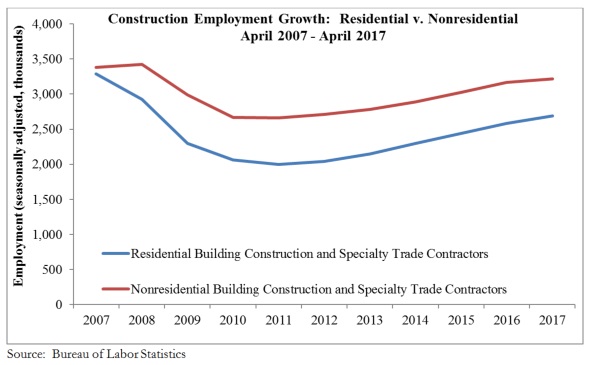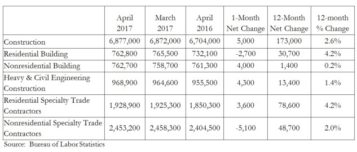
WASHINGTON, D.C. — National construction employment remained largely unchanged for the second consecutive month, adding 5,000 net new jobs on a seasonally adjusted basis in April, according to analysis of U.S. Bureau of Labor Statistics data released by Associated Builders and Contractors.
The nonresidential construction sector added 3,200 net new jobs in April after adding 8,500 net jobs in March (revised down from 13,300), while the residential sector added just 900 net jobs for the month. Construction employment expanded 2.6 percent on yearly basis, well above the year-over-year growth rate for all nonfarm industries (+1.6 percent).
“Today’s employment report confirms that the U.S. economic expansion remains firmly in place,” said ABC Chief Economist Anirban Basu. “That said, the simultaneous expansion in job totals and ongoing slow GDP growth indicate that the average net new job is associated with relatively low output. This is consistent with still-soft productivity growth and somewhat sluggish wage growth relative to expectations. Construction has been especially susceptible to weak productivity growth in recent years, in part because skilled workers capable of delivering elevated productivity remain in such short supply. The scarcity of skilled craftspeople helps explain the scant .2 percent growth in nonresidential building construction employment over the past year.
“Nonresidential construction added 3,200 net new jobs, however, nonresidential specialty trade contractors shed 5,100 net jobs in April,” said Basu. “It is conceivable that this occurred as certain segments of private development have begun to slow, including key commercial segments. Conversely, the loss in nonresidential specialty construction positions may simply be a one-month statistical anomaly.
“Recent construction spending data indicate that overall nonresidential construction activity is climbing only slowly,” said Basu. “This implies that hiring will remain moderate for the foreseeable future. Naturally, if the administration in Washington, D.C. is able to implement a significant portion of its pro-business agenda, the rate of job growth will eventually accelerate appreciably.”
The construction industry unemployment rate, which is available only on a nonseasonally adjusted basis, fell 2.1 percentage points in April and now stands at 6.3 percent. Due to seasonal factors, the industry unemployment rate almost always plummets from March to April. Since 2009, that decline as averaged 2.3 percentage points. The national unemployment rate inched down from 4.5 percent in March to 4.4 percent in April. This is the lowest nationwide rate since May of 2007.




 Join our thriving community of 70,000+ superintendents and trade professionals on LinkedIn!
Join our thriving community of 70,000+ superintendents and trade professionals on LinkedIn! Search our job board for your next opportunity, or post an opening within your company.
Search our job board for your next opportunity, or post an opening within your company. Subscribe to our monthly
Construction Superintendent eNewsletter and stay current.
Subscribe to our monthly
Construction Superintendent eNewsletter and stay current.